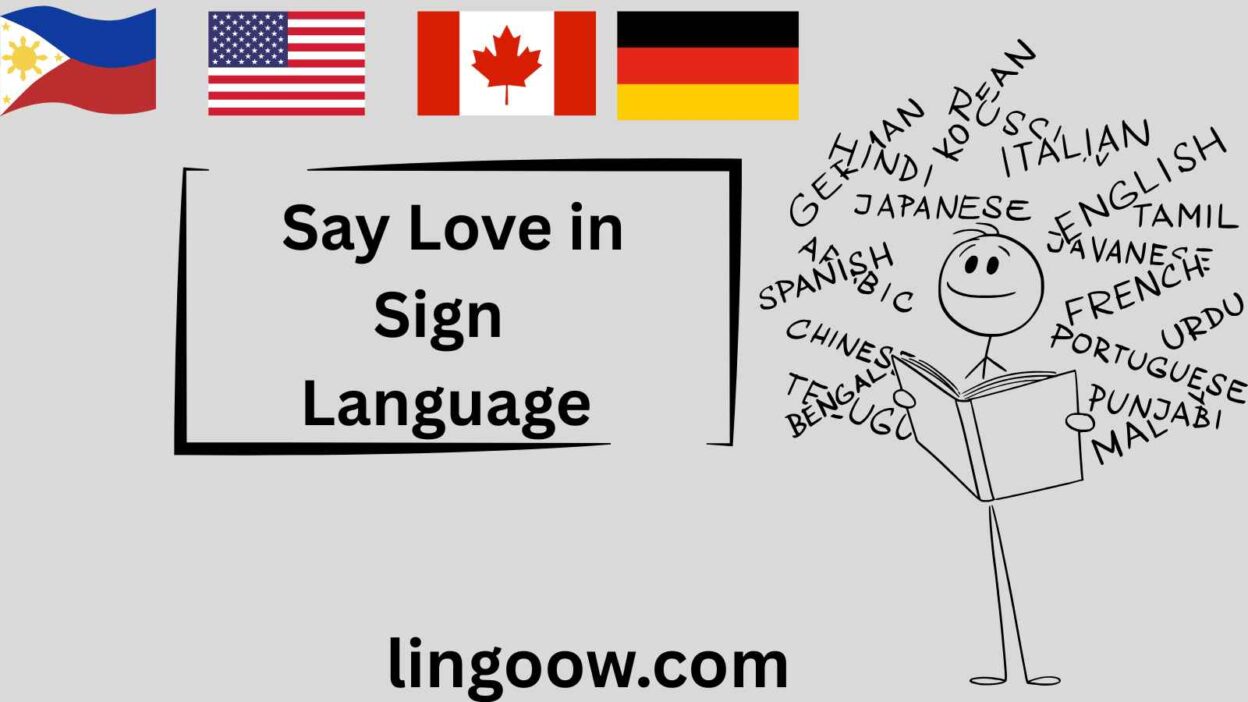Imagine this: You’re at an international Deaf conference, hearts racing from the buzz of connection.
Across the room, you lock eyes with someone from a distant corner of the world. Words fail—different spoken tongues, different signs—but when you both bring your hands to your chest, crossing them in a universal embrace, love flows effortlessly.
No translation needed. That moment? Pure magic.
This isn’t just my story; it’s the story of humanity. Love in sign language transcends borders, evolving uniquely yet echoing the same heartbeat worldwide.
From the passionate kiss of French Sign Language to the heart-squeezing warmth of German signs, these gestures remind us: love is visual, visceral, and profoundly universal.
No matter your culture, signing love pulls at the strings of the soul. Let’s dive into this beautiful tapestry—your hands might just learn to speak it too!
Quick Reference
Here’s your go-to table—print it, practice it, share it. Each sign captures love‘s essence, often iconically tied to the heart.
| Sign Language (Country/Region) | Sign Description | Cultural/Linguistic Insight |
| ASL (USA) | Cross flat hands (palms facing each other) over your heart, lean forward slightly. | Iconic “hug yourself”—used for romantic, familial, or platonic love; casual “love ya” uses ILY handshape. |
| BSL (UK) | Flat open hands cross over left side of chest. | Personal, introspective—reflects British reserve, yet deeply felt. |
| LSF (France) | Right hand to mouth (kiss), extend outward with flourish. | Romantic flair! Like a “long kiss”—tied to French passion. |
| DGS (Germany) | Hands to chest, squeeze as if compressing heart. | Emphasizes emotional intensity, mirroring German depth. |
| LSE (Spain) | Open hands circle and tap heart. | Vibrant, expressive—like a flamenco heartbeat. |
| LIS (Italy) | Hands expand from heart outward. | “Heart bursting”—celebrates love‘s joyful explosion! |
| JSL (Japan) | Gentle stroking motion near cheek/heart, like petting a beloved animal. | Subtle, nurturing—reflects Japanese harmony and quiet devotion. |
| KSL (Korea) | Fist circles over flat hand near heart. | Warm, enveloping—evokes K-drama tenderness. |
| CSL (China) | Hands draw heart shape on chest. | Simple, poetic—aligns with poetic love in Chinese literature. |
| ISL (India) | Two options: Stroke cheek (pet-like) or heart tap. | Diverse, familial—love for family, pets, or romance. |
| SASL (South Africa) | ILY handshape (thumb, index, pinky extended) waved casually or seriously. | Versatile for ubuntu spirit—love as community bond. |
| TID (Turkey) | Point emphatically to heart. | Direct, passionate—echoes poetic Turkish love songs. |
| PJM (Poland) | Similar to ASL: Hands cross chest. | Familiar yet personal—bridges Eastern European warmth. |
| NZSL (New Zealand/Maori) | Heart squeeze with cultural flourish. | Blends Maori aroha (compassionate love). |
| LSB (Brazil/Libras) | Dramatic hands to chest, sway. | Fiery, samba-like—love as life’s rhythm! |
European Sign Languages
Europe’s sign languages paint love with passion and precision. In France (LSF), that kiss-blow? It’s pure amour—think Eiffel Tower smooches! Across Spain (LSE), Italy (LIS), and Germany (DGS) (spanning 20+ countries like Poland, Austria, Sweden, the Netherlands, Belgium, Switzerland, Portugal, Greece, and beyond), signs revolve around expanding or squeezing hearts, reflecting Mediterranean fire and Nordic depth. UK’s BSL keeps it crossed and cozy, like a stiff upper lip melting. Culturally? Love here ties to art—Renaissance sonnets, fairy tales—making signs feel like living poetry.
Asian Sign Languages
Asia’s diversity shines! Japan (JSL) strokes gently, evoking quiet ai (love). Korea (KSL) circles warmly, China (CSL) draws hearts—spanning Japan, Korea, China, India, Pakistan, Turkey, Indonesia, Thailand, Vietnam, Malaysia, Singapore, Philippines, Bangladesh, Sri Lanka, Nepal, Myanmar, Mongolia, Taiwan, Hong Kong, and 20+ more (including Jordan, Egypt, UAE, and Syria’s variants).
Arabic sign languages often point to the heart with mouth shapes for nuance.
Insight: In collectivist cultures, love signs emphasize harmony—family first, romance a gentle wave. From Bollywood drama to K-pop confessions, these gestures whisper eternity.
African Sign Languages
Africa pulses with ubuntu—I am because we are. South Africa (SASL) flashes ILY for quick love bombs.
Kenya, Nigeria, Ghana, Ethiopia, Tanzania, Uganda, Zimbabwe, Zambia, Morocco, Algeria, Tunisia, Egypt, Senegal, Ivory Coast, Cameroon, Rwanda, Botswana, Namibia, Angola, Mozambique (20+ countries) favor chest taps or heart beats, blending Swahili upendo vibes. Zulu influences add rhythmic sway.
Culturally, love is communal—tribal dances, storytelling—signs invite the village in, healing divides.
Indigenous & Island Sign Languages
From New Zealand (NZSL/Maori aroha)‘s squeezes to Hawaii’s HSL (heart-cross with aloha spirit), Samoan SL‘s embraces, and Cherokee gestures (chest taps echoing spoken adageyudi). Spanning Pacific islands (Fiji, Tonga, Tahiti, Papua New Guinea), Americas (Plains Indian Sign Language, Inuit Sign Language), Australia (Auslan with Aboriginal influences), Canada, Mexico, Peru, Bolivia, and 20+ more—love here honors ancestors, nature. Insight: These signs weave survival stories—resilience in every motion.
Cultural Insights
Signs for love date to 18th-century Deaf schools (LSF pioneered). Early ASL (1910): Flat hands over heart. Iconicity rules—natural gestures persist. Religion? Biblical agape in chest-crosses. History? Colonial exchanges spread ASL variants, but locals adapt. Power: In wars, disasters, love signs unite Deaf communities globally.
Famous Proverbs on Love: Echoes in Every Gesture
- Italian: “Love does good even to the bad.” (Sign it with expanding heart!)
- Chinese: “A loveless life is like a barren field.” (Heart-draw nod.)
- African (Swahili): “Love is like a baby: it needs to be treated tenderly.”
- Japanese: “The best thing to hold onto in life is each other.”
- Maori: “Love is the water of life.”
These ring true—sign them next time!
FAQs
Why do so many signs look similar?
Iconicity! Humans naturally hug hearts for love—evolution at work.
What’s the oldest known “love” sign?
Traces to 1700s LSF; gestures likely prehistoric.
Cultural differences?
Europe: Passionate. Asia: Subtle. Africa: Communal. Islands: Ancestral.
Conclusion
From chest crosses to kiss-blows, love in sign language proves: We’re wired the same. It heals, unites, transcends. Your turn: Practice ASL’s cross—feel the rush? Share your country’s sign below, tag a friend, or film yourself signing love! What’s your love story? Drop it in comments—let’s spread the silent symphony. ❤️ #SignLove




